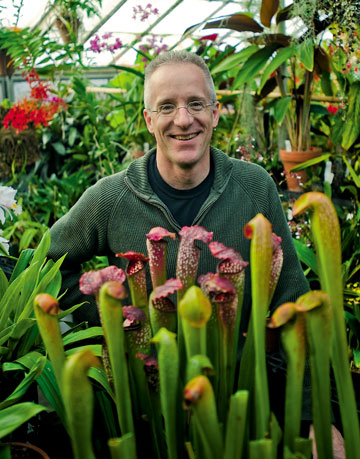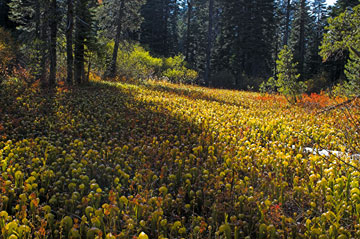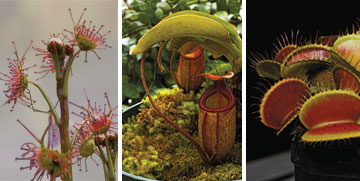Volume 27 · Number 2 · Winter 2010
Hungry Garden

Barry Rice with some of the leafy meat eaters that he has helped cultivate at the UC Davis Botanical Conservatory. The greenhouse complex houses one of the world's largest collections of carnivorous plants. (Cheng Saechao/UC Davis).
Watch a video interview...
Hidden among the rows of delicate ferns and elegant orchids in the UC Davis Botanical Conservatory, a killer lies in wait. Motionless, the predator lures its prey with the glistening promise of nectar droplets along its leaves. But appearances can be deceiving. A hapless moth lands to drink and becomes entangled with so much slime that it suffocates.
Tentacles bend toward the prey and ooze more digestive enzymes around the moth. Just another meal for Drosera rotundifolia, or the roundleaf sundew — one of approximately 150 species of carnivorous plants cultivated at the greenhouse complex.
Plant lovers may know of the conservatory as home to Amorphophallus titanum, or the titan arum, whose rare, large blooms are said to smell like ripe road kill. But the 3,600-square-foot complex north of Storer Hall also houses the largest assortment of carnivorous plants at any university in the country. In fact, the collection is one of the largest in the world, according to the International Carnivorous Plant Society (ICPS).
“We have hundreds of species here for the touching,” says Barry Rice, an expert carnivorous plant horticulturalist and associate scientist with the University of California’s Center for Biodiversity. “Anyone can come and see them.”
The touching might seem risky; these botanical carnivores do, after all, rely on eating animals for a living. But despite science fiction portrayals of plant monsters capable of devouring human flesh, Rice says he doesn’t worry about working alone in the greenhouse — well, not usually. With his help, UC Davis’ collection has flourished to include a strong representation of the approximately 700 species of carnivorous plants found on every continent except Antarctica.
Rice’s enthusiasm for learning about these botanical specimens is infectious. He’s the Steve Irwin of the carnivorous plant world, bouncing around the greenhouse with the energy of a 5-year-old boy after two bowls of Fruit Loops.
“Take a look at this pitcher plant,” Rice says to a group of greenhouse visitors as he snatches up a specimen of Nepenthes bicalcarata. He explains that ants live near the perimeter of this plant in Borneo and act as a “neighborhood watch system” to protect it from a certain species of weevil that eats the tender shoots.
“If you snap your fingers next to one of these plants in the wild, mimicking the sound of the weevil, ants will come swarming out,” Rice adds with a grin. “This way, the plant fears no weevil.”
Rice began his fascination with carnivorous plants while a doctoral student in astronomy as a way to blow off steam from the pressures of graduate research and has been growing them since 1985 (not counting the Venus flytraps he unintentionally killed as a child.) He is so passionate about them that he and his wife, Beth, a fellow nature lover, even spent five days of their honeymoon in the spring of 2002 canoeing through the Okefenokee Swamp in Georgia looking for carnivorous plants growing on the floating mud flats, among alligators and water moccasins. Okefenokee is the only site in the world where the giant form of the pitcher plant Sarracenia minor can be found.
Rice’s foray from the stars to the plant world led him to work as a member of The Nature Conservancy’s global invasive species team from 1997–2009, while holding a visiting scholar appointment at UC Davis. In his spare time he edits the Carnivorous Plant Newsletter — the journal of the ICPS based in the Contra Costa County city of Pinole. Rice returned to teaching astronomy at Sierra College in Rocklin this past August, but remains a presence in the Davis conservatory as a herbarium research associate.
Maintaining carnivorous plants is no easy task, but if you’re interested in keeping them as “pets,” first find out what they like, Rice says. His book, Growing Carnivorous Plants, illustrated mainly with his detailed photographs, provides insight into the specific habitat requirements of different species as well as entertaining history. Rice also recently finished Monster Plants, a new book with Scholastic Press for ages 9–14 that “talks about cool stuff like carnivorous plants, parasitic plants, mycoparasites, stinky flowers, and other weird stuff.”

Hungry forest: A California wetland provides ideal conditions for Darlingtonia to flourish. (Barry Rice Photo)
Even though carnivorous plants may have been around as early as the Cretaceous period, when dinosaurs roamed the earth, scientists were slow to accept the notion that plants could be killers. After all, they can’t get up and move around to stalk their prey. Even the “father of taxonomy,” Carolus Linneaus, couldn’t grasp the concept of plants as carnivores. Not until the mid-to-late 1800s, when scientists could clearly demonstrate that some of these plants were carnivorous, was the idea fully embraced.
Charles Darwin was one scientist fascinated by these flora and went on to publish Insectivorous Plants in 1875. In one of his many letters across the Atlantic to his friend, preeminent American botanist Asa Gray, Darwin wrote, “I care more about the history of the Drosera than the origin of all the species in the world.”
Carnivorous plants interest scientists and nonscientists alike because they defy what we think of as a plant. Having evolved to grow in nutrient-poor locations, carnivorous plants thrive in conditions where most other plants would die. Even without the ability to pull up roots and hunt for food, these plants have mastered numerous ways to capture and eat their prey — secreting nectar to lure bugs into a leafy bowl of digestive slime, emitting sticky goo on leaves to trap and suffocate flying insects, snapping leaves shut to close in for a kill.
Despite their creative ways of capturing prey, carnivorous plants can’t outsmart climate change and habitat destruction. While animals can migrate from areas being affected by variations in temperature, rainfall and fire frequency, plants usually live only in favorable areas and can’t quickly respond.

Sundews (left) and butterworts (Drosera and Pinguicula) emit sticky goo on leaves that attract ants, moths, butterflies, mosquitoes and craneflies—all doomed to suffocation by a coating of mucous.
Napenthes rajah (center) has the largest “mouth” of all carnivorous plants. It captures frogs, of which the last thing to be digested is the skin on their hands. If you look inside N. rajah and count the number of little frog gloves, divide by four and that’s how many frogs the plant has recently eaten.
Napenthes, a genus of pitcher plants primarily found in the tropics of southeast Asia, is similar in shape to a toilet bowl—complete with lid. Nectar on the lid attracts bugs and insects who slip on the slick surface and fall into the bowl of the plant where a pool of mucous slime, full of digestive enzymes, eats away at them. Smaller bugs draw a host of other animals including spiders, centipedes, cockroaches, frogs and even mice.
The more familiar Venus flytrap (Dionaea muscipula), right, snaps shut on its prey, but not right away. Touch the small trigger hairs on the inside of its leaves once and nothing happens. The second time the trigger hairs are disturbed, the plant closes in for the kill.
(Barry Rice photos)
Rice likens carnivorous plants to canaries in a coal mine. They are disappearing at a rapid rate — even in natural habitat that appears unthreatened. And those areas aren’t just beyond the borders of this country. Venus flytraps are down to a handful of locations in North and South Carolina.
Saraccenia oreophila, a pitcher plant on the federal endangered species list, can be found in the wild in only 20 locations in Alabama, North Carolina and Georgia. No more than a few individual plants remain in some of those places.
That’s where the work at the UC Davis Botanical Conservatory comes in. Not only are carnivorous plants grown here for public outreach, education and classes, researchers like Rice are also keen on preserving them in the wild.
In cases of very rare plants like S. oreophila, Rice and others working at the conservatory cross-pollinate the plants to produce seeds and send them off to a seed bank for the International Carnivorous Plant Society. The society may then distribute the seeds to members in accordance with the endangered species act laws. The conservatory may also legally sell plants to horticulturalists in California to decrease poaching pressures.
“It’s refreshing to see such outstanding efforts taken by UC Davis to preserve these fantastic plants in cultivation for future generations,” says Brian Barnes, director of conservation for the ICPS and president of the Florida Carnivorous Plant Society.
Poaching, climate change and habitat destruction pose a risk to the survival of carnivorous plants throughout the world. In the United States, 95 percent of wetlands habitat where these plants grow has been destroyed to make room for housing and other development.
“We talk about what people should do in other countries to protect their rain forest, grasslands, and natural habitats, but we’re squandering a natural heritage in our backyard,” Rice says. “We only have small bits of native habitat for carnivorous plants left and we need to work to protect them. These plants are like our pandas — extraordinary organisms that we want to keep for the future.”
